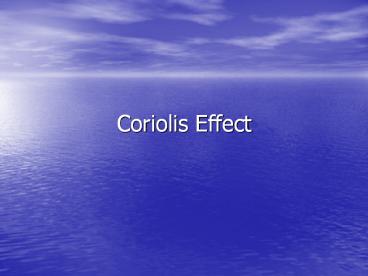Coriolis Effect - PowerPoint PPT Presentation
1 / 21
Title:
Coriolis Effect
Description:
... Maps. Scientists and weather forecasters use weather maps ... on the maps to help them see what is going on with the weather in various parts of the country. ... – PowerPoint PPT presentation
Number of Views:505
Avg rating:3.0/5.0
Title: Coriolis Effect
1
Coriolis Effect
2
Weather Maps
3
Scientists and weather forecasters use weather
maps to help them see weather patterns.
4
They place symbols on the maps to help them see
what is going on with the weather in various
parts of the country.
5
A Cold Front symbol shows the edge of a mass of
cool air.
6
A Warm Front symbol shows the edge of a warmer
air mass.
7
A Stationary Front means neither the warm air or
the cool air are moving very much.
8
How many fronts can you identify on this map?
9
A large H means an area of higher pressure.
H
Higher pressure usually means nice, clear weather.
10
Which state has high pressure?
11
A large L means an area of lower pressure.
L
Lower pressure usually means clouds, rain, or
snow.
12
How many Lows are on this map?
13
How Can you Tell?
L
H
Pressure Gradient Force (PGF) Air moves from
high to low pressure.
14
How Can you Tell?
L
H
(Northern Hemisphere)
Pressure Gradient Force (PGF) Air moves from
high to low pressure. Coriolis Effect Air
moves counterclockwise around low, clockwise
around high pressure.
15
Rotation of the earth produces
Coriolis Force
(gravitational, pressure gradient, frictional,
Coriolis)
Earth spins west to east (eastward)
Eastward velocity is greatest at equator and
decreases poleward
Coriolis force is zero at equator and maximum at
poles
16
(No Transcript)
17
(Pinet)
18
(No Transcript)
19
El Nino Conditions
High/Low Pressure system weakens
Area that is normally dry
SE Trades stop or even reverse
warm water
Gradient in Sea Surface Height degenerates
Warm, nutrient-poor water moves east
20
Introduction to Our Weather Prediction Task
The weather at X is getting warmer. True or false?
X
21
- Air will move counterclockwise inward -
Weather at X will get colder































